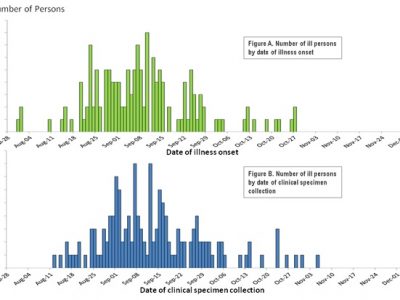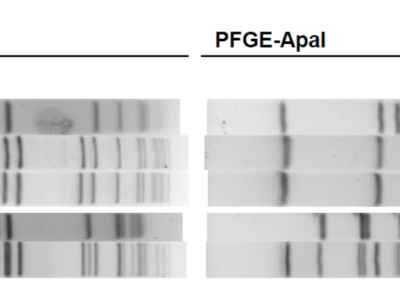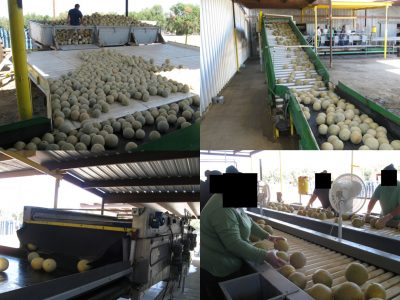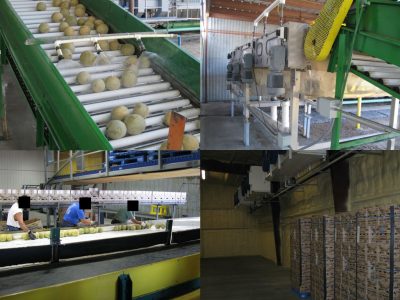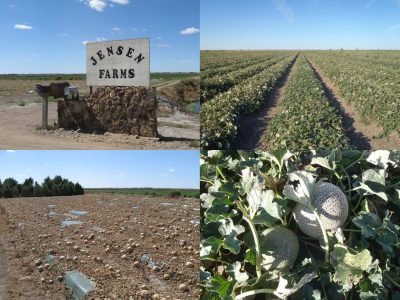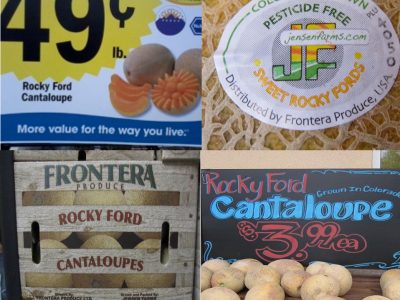| Outbreak: Colorado Cantaloupe Listeria | |
|---|---|
| Product: Jensen Farms (Colorado) “Rocky Ford” cantaloupe | Investigation Start Date: 8/29/2011 |
| Location: Multi-state | Etiology: Listeria monocytogenes |
| Earliest known case onset date: 7/31/2011 | Latest case onset date: 10/27/2011 |
| Confirmed Case Count: 147 | Positive Environmental/Food Samples: 12 / 22 |
| Hospitalizations: 143 | Deaths: 33 |
In 2011 a multistate outbreak of Listeria monocytogenes infected 147 people, including 143 hospitalizations and 33 deaths. Illnesses were associated with Colorado cantaloupes marketed as “Rocky Ford” grown at Jensen Farms.
- • Supplemental Listeria questionnaire used in the Outbreak (PDF)
- • FDA Press Release, September 29, 2011 (PDF)
- • CDC Outbreak Page Final Update
On August 29th, 2011, two cases of Listeria monocytogenes were reported to the Colorado Department of Public Health and Environment (CDPHE). These were in addition to a L. monocytogenes case that had been reported in mid-August, bringing the total number of cases for August to three, which was unusual. By the end of August, a total of 8 cases were reported with three distinct PFGE patterns. Initial interviews using the Centers for Disease Control and Prevention (CDC) “Listeria Initiative” questionnaire implicated cantaloupe, ice cream, coleslaw, and deli meats as potential common sources of illness. While cantaloupe had not previously been associated with L. monocytogenes outbreaks, it had been added to the questionnaire after a 2000-02 FoodNet case-control study identified an increased association between illness and cantaloupe consumption.
CDPHE notified CDC of the outbreak on September 1st. CDC provided CDPHE with data from the “Listeria Initiative” database to conduct case-case studies to compare cases from the current Colorado outbreak with previously reported sporadic listeriosis cases. Because there were multiple PFGE patterns among the outbreak cases, investigators were initially unsure whether cases represented a single or multiple outbreaks.
By September 6th, there were 12 listeriosis cases and suspected food vehicles included cantaloupe, watermelon, and ham. Later the same day, the CDC informed CDPHE that Nebraska and Texas had reported L. monocytogenes cases with PFGE patterns that were indistinguishable from the Colorado cases.
From September 4th through 7th, epidemiologists collected various food items from patients’ houses for testing and the CDPHE laboratory purchased cantaloupe from three grocery stores. Only cantaloupe with an identifying produce sticker attached were purchased, as grocery store bins of cantaloupe labeled “Colorado Grown” often contained produce from multiple Colorado growers and occasionally other states. Preliminary laboratory results demonstrated that all cantaloupe from one grocery store tested positive for L. monocytogenes. On September 9th, results from the “Listeria Initiative” case-case study indicated only cantaloupe was statistically associated with illnesses. A media release warned consumers that those at high risk for L. monocytogenes infection should avoid eating cantaloupe. CDPHE informed Colorado cantaloupe growers of their concerns and arranged farm visits.
Investigators first visited Jensen Farms on September 10th. September is the end of the cantaloupe growing season in Colorado, and Jensen Farms was the only local farm still producing cantaloupes. The investigation team noted the farm changed their handling processes earlier in the year. They replaced a chlorinated water wash with new equipment that sprayed cantaloupes with municipal water and used a series of felt rollers and brushes for cleaning and drying. At the end of this process, cantaloupes were packed in boxes and refrigerated. This new process lacked a pre-cooling step and therefore did not remove “field heat” from the produce, which allowed condensation to form on the cantaloupe once boxed and refrigerated. Additionally, the new processing equipment could not be dissembled and disinfected. Investigators hypothesized L. monocytogenes colonized the equipment and was subsequently sprayed onto all processed cantaloupe. The suboptimal storage conditions further allowed the organism to multiply.
Ultimately, five PFGE patterns were identified in patient and environmental samples. Of these, all five patterns were identified from cantaloupes obtained from patient homes, four patterns were identified from cantaloupes at retail locations, three patterns were identified from environmental swabs taken at the processing facility, and two patterns were identified from cantaloupes sampled directly from the Jensen Farm’s cooler. While the initial source of contamination was never determined, all contamination of produce occurred downstream of the processing equipment. It is possible that the equipment, which was refurbished from a potato farm, was previously contaminated. Alternatively, the cantaloupes may have been contaminated prior to processing and the pathogen was amplified by the equipment. However, testing of growing fields were negative and examination of growing methods provided no evidence of their contribution to the contamination. It is also possible that contamination entered the facility via a truck that routinely carried agricultural waste between the farm and a nearby cattle ranch. The incidence of polyclonal L. monocytogenes outbreak-related strains indicates multiple niche sites, extensive and multiple contamination sources, or repeated introductions within the processing facility.
In total, there were 147 cases (40 in Colorado) in 28 states and 33 deaths (9 in Colorado). Cases were primarily older adults and very few pregnant women, as compared to other L. monocytogenes outbreaks. Investigators hypothesized pregnant women consumed cantaloupe more quickly than older adults, thereby preventing further multiplication of L. monocytogenes in their home refrigerators.
Public health increasingly identifies fresh produce as a vehicle for foodborne illness and novel pathogen-vehicle combinations. Jensen Farms’ introduction of new processing equipment and failure to follow FDA guidance about safe melon handling likely promoted L. monocytogenes contamination and colonization. In this outbreak, rapid collection of environmental specimens, coupled with the “Listeria Initiative” that facilitated rapid case-case comparisons between outbreak-related and sporadic cases, allowed for rapid identification of a food vehicle, and prompted swift intervention measures.

